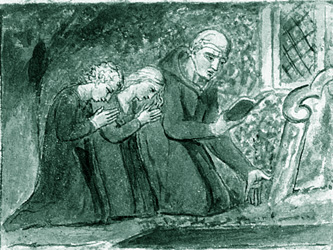Are you looking for a poem analysis of The Garden of Love By William Blake? Great, we have the best analysis you are going to find anywhere.

The Garden of Love Analysis: Meter and Rhyme
Any Analysis of The Garden of Love by William Blake should note the following point about meter and rhyme:
- The poem is made of three quatrains, that is, three stanzas of four lines each.
- Almost every line in the poem is either eight or nine syllables until the last two lines, which are ten syllables.
- Although the count doesn’t quite match at times, all lines of the poem, except the last two are roughly in anapestic trimeter. The last two lines then form a tetrameter.
- The rhyme scheme of the first two stanzas is ABCB. In other words, only the second and fourth line rhymes.
- Although no lines in the third stanza rhyme, there is internal rhymes in the last two lines. “Gowns” nearly rhymes with “rounds,” and “briars” with “desires.”
- The first rhyme in the poem makes use of a long E sound. Note that when you make a long E, you have to smile. The poem starts out almost upbeat as it talks about childhood.
- The second rhyme in the poem, is the oor-sound. This is a dour sound and conveys the beginnings of distress.
- The penultimate line of the poem makes use of a sound that expresses pain, as when you say “ow!”
- The final rhyme in the last line calls to mind both ire and fire and conveys anger.
Our analysis of The Garden of Love by William Blake reveals to us that the meter grows continuously grows more complex and somber, as do the rhymes. This communicates William Blakes growing distress with what has happened to his innocent garden. We’ll discuss this more below.
The Garden of Love Analysis: the First Stanza

When we read the above lines in The Garden of Love by William Blake, we think of the garden of Eden. In the garden of Eden, Adam and Eve lived in complete innocence. They possessed the innocence of children. They had no guilt over either love or sex.
We think that William Blake regarded the organized Church, in this case, as something akin to Satan. The Chapel appears in the garden as something evil. Consider that a chapel is completely unnatural. It’s shape is squarish and triangular, unlike the natural roundness of nature. In this setting, the Chapel is artificial, forced, and out of place.
In our analysis, we feel this conveys William Blakes deep antipathy toward organized religion. William Blake was deeply religious, but he liked neither the church of England nor any type of organized religion. He felt the Church, in general, had perverted the real meaning of Christ’s love.
The Garden of Love Analysis: the Second Stanza

We find the lines of the second stanza of The Garden of Love by William Blake to be particularly poignant. First, note that entry has been barred. While once it was permissible to enter and leave the garden freely, access is now controlled by a gate keeper. One cannot freely enjoy pleasure without permission from the Church.
Our analysis must make note of the horrible “thou shalt not.” We feel this is in reference to free love. In the garden of Eden, Adam and Eve freely loved one another without any sense of shame. While in the original story of Eden eating the fruit of the tree gives Adam and Eve knowledge, in this case, the fall is a bit different. The Church in its attempt at creating control seems to outright destroy love. The church forbids it.
Why does the organized church do this? Is it because the church, itself, is Satan? These are good questions for the reader to consider, and our analysis must stop short of answering these questions.
The Garden of Love Analysis: the Third Stanza

The important point for our analysis of The Garden of Love by William Blake is to note that in the third stanza, death comes into the picture.
When Adam and Eve ate of the fruit in the garden of Eden, they gained knowledge not only of carnal relations but death. There something almost poetic in learning about procreation and death simultaneously. Procreation becomes a duty so that death can be avoided.
We stop loving just to spontaneously love, and we then procreate to avoid death, which we fear. Spontaneous love is replaced with moral responsibility and fear. William Blake feels this is wrong, and that the Church incorrectly is instilling these ideas. He feels the Church instills these values mostly for political control.
Blake wants to suggest that love is sufficient for us, and we are happier and better off when we simply love. We should not fear death, and then procreate solely out of moral responsibility. The Church has perverted the real Christian message, and Blake wants to reveal the true message to us in his poem.

The Garden of Love Analysis: Summary
We find The Garden of Love by William Blake to be a wonderful poem. We feel the poem recreates the garden of Eden story, and places the blame for the fall squarely on man’s need to control his environment in fear of death. Blake sees the Church as an evil organization instilling the wrong values in people. Blake wants to urge us to let go of our fears, and to again, trust in love as our guiding principle. In this case, Blake wants us to let go of organized religion, because he feels it is an impediment to our ability to freely love.
We hope you enjoyed our analysis of The Garden of Love by William Blake. Don’t forget to subscribe to our poetry newsletter for future great posts!